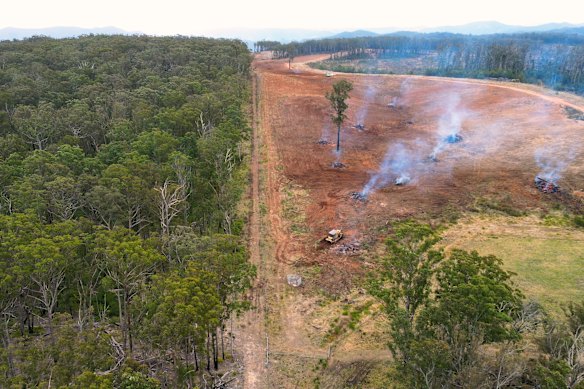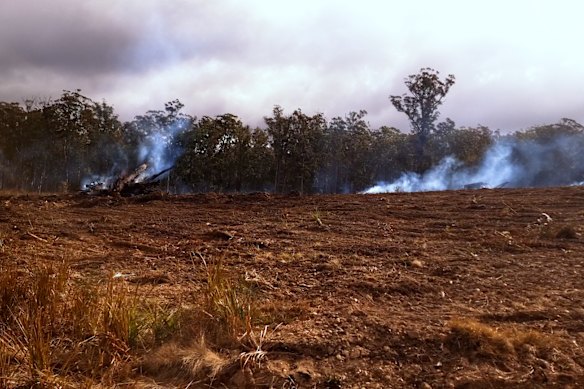‘Perverse outcomes’: NSW a deforestation hotspot on par with Indonesia
Land-clearing in NSW surged by 40 per cent in 2023, making NSW a deforestation hotspot on par with Indonesia, as environmentalists slam the Minns government for failing to ditch rules driven by former Nationals leader John Barilaro after more than two years in government.
The figures from the annual NSW Statewide Landcover and Tree Study (SLATS) released on Monday reveal 66,498 hectares of the state’s native vegetation were destroyed in 2023 – the equivalent of 237 Sydney CBDs or four times the size of Royal National Park – and more than half was unallocated to any law. The figure is a 40 per cent rise from the revised figure of 47,388 hectares cleared in 2022.

An aerial image of land-clearing at Yarrowitch in the NSW Northern Tablelands. There is no suggestion of illegality.Credit: Australian Conservation Foundation
The clearing of woody vegetation (trees and shrubs) jumped from 21,137 hectares in 2022 to 32,847 hectares in 2023. Australian Conservation Foundation campaigner Nathaniel Pelle said this was “on par with the amount of forest that is cleared every year for palm oil in Indonesia” – about 30,000 hectares in 2023.
“It’s a lot ... for a rich country to be still clearing [more than] 30,000 hectares of forest and woodland in a year, and for that clearing rate to be going up,” said Pelle.
The SLATS data also revealed 33,651 hectares of non-woody vegetation (grasslands, ferns and ground cover) was cleared, up from 26,251 hectares the previous year.
Pelle said the surge in 2023 was probably “panic clearing” ahead of anticipated legal reforms, since Labor came to power promising to fix land-clearing laws that had been loosened by the former Coalition government in 2016.
“If you telegraph that you’re going to do something, and then don’t, it can have perverse outcomes,” Pelle said. “We need more than just words from the Minns government on reforming these rules and their enforcement or compliance.”
In late 2024, the government overhauled the 2016 Biodiversity Offset Scheme, which allows developers to pay to destroy biodiversity, acting on a scathing review by former Treasury Secretary Ken Henry. The government also promised to reform the Local Land Services Act, which governs clearing on private land, but its proposed legislation remains in consultation stage.
The Department of Climate Change, Energy, the Environment and Water said two-thirds of the 9603 hectares cleared under the Local Land Services Act was for management of “invasive native species”, which it said were native woody plants that either regenerate thickly following disturbance or encroach on vegetation communities where they previously did not occur.
The average annual clearing of woody vegetation for agriculture was 8857 hectares a year from 2009 to 2015, and jumped to an average of 19,829 hectares a year from 2016 to 2023.
From 2018 to 2023, the state has cleared 478,750 hectares of land – more than twice the area of the Australian Capital Territory. Of that, 39 per cent was forest and woodland and 61 per cent was non-woody vegetation.

Land-clearing in Yarrowitch in the NSW Northern Tablelands in 2023. There is no allegation the clearing was illegal.Credit: Australian Conservation Foundation
Agriculture accounted for 82 per cent of all clearing since 2018, compared with 12 per cent for infrastructure and 6 per cent for forestry. In 2023, agriculture caused 60 per cent of clearing of forest and woodland and 96 per cent of non-woody clearing.
The department said 96,506 hectares had been set aside for conservation on privately managed land as of January 1, 2024.
Jacqui Mumford, chief executive of Nature Conservation Council NSW, said it was alarming to see that the state had not reversed the trend of habitat destruction on private land, especially after the recent State of the Environment report made it clear that biodiversity was “going from bad to worse”.
“It’s been more than two years since the election, and the key commitments that the Minns government made on the environment were the Great Koala National Park and reining in runaway land-clearing, and we haven’t seen either,” Mumford said. “The big question for us is why is it taking so long? When are they going to start turning this around? And when is enough enough?”
Mumford said the Minns government had shown it was able to act quickly on some issues, so its inaction indicated the environment was not a priority.
University of NSW Scientia Professor Richard Kingsford, a member of the Wentworth Group of Concerned Scientists, said land-clearing was one of the major threats to biodiversity, and the Minns government was “running out of time” to deliver its promises.
“They did promise to fix it, and we’re more than halfway now through the term,” Kingsford said. “These difficult issues are usually tackled early on in a government, and it becomes more difficult as you get closer to an election.”
Kingsford said land-clearing was the biggest threat to biodiversity, but there was also an economic imperative to act.
European Union rules for imported beef to be deforestation-free take effect at end of this year. Although the definition was watered down after lobbying by the Australian government, Kingsford said the underlying pressure would influence access to markets over the next decade.
Pelle said corporations including Woolworths, Coles, McDonald’s and Westpac had also made commitments on deforestation-free beef that would be guided by science.
Deforestation remained higher in Queensland, though the state had more intact forest than NSW and better data, Pelle said. The scale of land-clearing was unclear in Western Australia and the Northern Territory.
The SLATS figures, which are based on satellite imagery, show deforestation hotspots in the Central West and Orana region south of Dubbo, around the Pilliga, and in the Northern Tablelands.
Glenn Morris, who manages beef cattle properties in Grafton and Inverell, said he did not know of any economic pressures that would have caused a surge in land-clearing in 2023, and the theory that “irresponsible” people were trying to beat incoming regulation was possible.
Land-clearing harmed the ocean as well, he said, pointing to the fact the algal bloom in South Australia was linked to nutrient-rich floodwaters coming down the Murray River as well as marine heatwaves.
“When we clear land, we’re actually causing runoff to get stronger and greater,” Morris said. “All around me [in Inverell], I’m seeing cropping country in heavy rainfall running into the Murray Darling system, which then ends up coming out exactly where the algal bloom is. All these issues are linked.”
Get to the heart of what’s happening with climate change and the environment. Sign up for our fortnightly Environment newsletter.